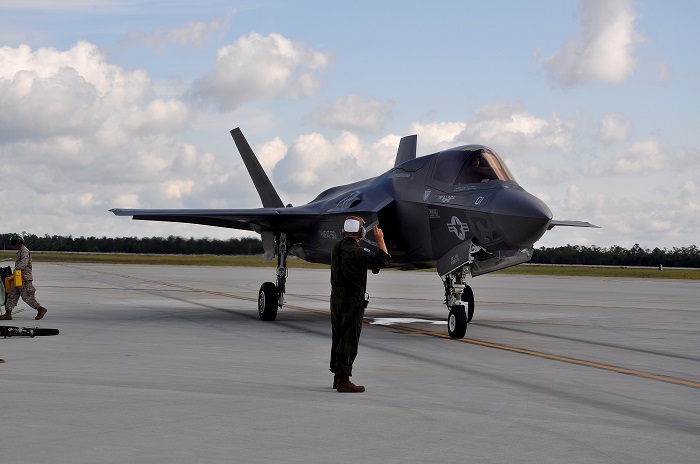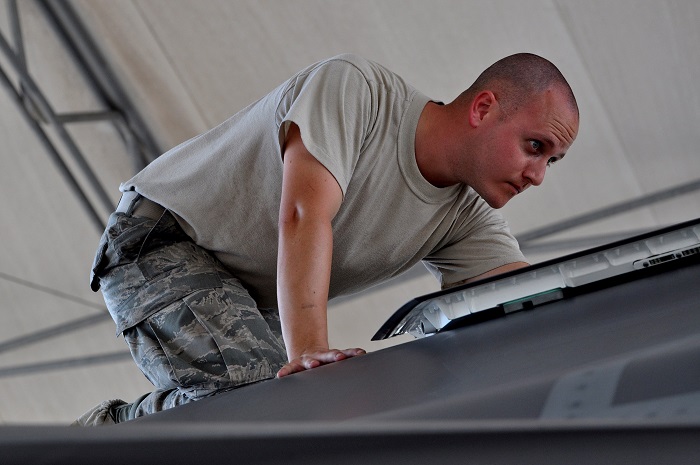.

A U.S. Marine Corps plane captain, known as a crew chief in the Air Force, marshals out an F-35B Lightning II short takeoff and vertical landing variant of the aircraft May 22, 2013, at Eglin Air Force Base. The maintainer orchestrated a "hot pit" ground refueling, running the engine while receiving fuel, allowing it to take off immediately afterward for another training sortie. Assigned to the Marine Fighter Attack Training Squadron-501, the plane captain helped train up 24 U.S. and United Kingdom pilots flying the B variant to date by having aircraft ready for the daily flight operations.
.
Airmen and Marines assigned to the F-35 Integrated Training Center at the 33rd Fighter Wing here have consistently flown successful training sorties and generated their 2,000th sortie Aug. 13 with an instructor pilot of the Marine Fighter Attack Training Squadron-501 (VMFAT-501), at the controls.
Marine Maj. Adam Levine, who flew in a two-ship formation, said he was surprised with the news upon landing but said that is typical since the flightline members are focusing on safe and effective flying rather than keeping pace with data tracked by those in statistical analysis.
“Every sortie, every takeoff, every hour is a win for the F-35 enterprise,” he said. From his cockpit, Levine also witnessed the first taxi of the U.S. Navy’s F-35C carrier variant preparing for its maiden flight from Eglin AFB.
With the Air Force, Marine Corps and Navy pressing forward to meet goals of initial operating capability in the next few years for their respective services, getting ample time in the air is crucial to meeting their timelines.
“Flying the 2,000th sortie highlights the accomplishments of the entire F-35 airpower team at Eglin AFB and moves us one step closer to the aircraft’s initial war fighting capability,” said Col. Todd Canterbury, the commander of the 33rd FW.
The Eglin AFB F-35A, B, and C variant joint training has been accomplished while operational and developmental test missions at flight test sites on the east and west coasts have been conducted simultaneously -- a process known as concurrency.
In these last couple weeks, Eglin AFB officials sent a handful of their pilots to Luke Air Force Base Ariz., to become the initial cadre of F-35A leaders at the 61st Fighter Squadron, 56th Fighter Wing, said Col. Stephen Jost, the commander of the 33rd Operations Group here. Luke AFB’s first joint strike fighters are scheduled to arrive in spring 2014 with plans to grow to 144 aircraft in the out years.
For now, the Eglin AFB-based flyers are expanding their training curriculum as they double up to full aircraft strength in the spring with all 24 Air Force F-35As expected to be on base. Jost will lead the group’s transition to the Block 2A aircraft, which carry upgraded computer software, in the first quarter of calendar year 2014 in order to accommodate more aircraft capabilities.
“We will increase the current syllabus from 6 student sorties to 8 and even 9 depending on when we will be cleared by the test community to fly at night,” Jost said.
Aside from flight operations, this also entails transitioning the ground school instruction such as flying more advanced scenarios in the full mission simulator.
“The primary capability of Block 2A is use of the plane’s multifunction advanced data link,” he said.
Currently, voice transmission is the primary means of communication.
While Air Force planners is busy seeding Luke AFB with an initial F-35 team, the Marines have been doing the same for Marine Corps Air Station Yuma, Ariz., just a short flight away.
Having trained up the initial cadre of U.S. and United Kingdom pilots and maintainers at VMFAT-501, Marines at Eglin AFB continue to train instructor pilots with a portion of the classes’ students being operational test pilots. These pilots are standing up MCAS Yuma’s operations at Marine Fighter Attack Squadron-121, Levine said.
In the near future, Eglin AFB’s VMFAT-501 is preparing to conduct its first local short take-off and vertical landing of the F-35B, an accomplishment realized at MCAS Yuma in March that the VMFAT-501 helped make possible. Meanwhile, the Navy's Strike Fighter Squadron 101 at Eglin AFB, has conducted its first maintenance check flight yesterday, is preparing for its first student flight this week.
In the upcoming years, when operating at full capacity, the Eglin AFB fleet will grow to 59 aircraft with about 100 pilots and 2,100 maintainers graduating yearly.
The F-35 joint strike fighter program is a joint, multi-national program. In addition to U.S. armed forces, the F-35 increases operational flexibility and interoperability with the eight other international partners participating in the development of the aircraft. They are the United Kingdom, Italy, the Netherlands, Turkey, Canada, Australia, Denmark, and Norway.
With so much history in the making, the F-35A, B and C fighter units at Eglin AFB are making strides for airpower for years to come, officials said.
“The versatile and high-tech aircraft will carry the U.S. Air Force, Marine Corps and Navy into the next 50 years of air dominance, and the men and women here can reflect back knowing they were among the pioneers in its initial phases,” Canterbury said.
.

Navy Lt. Cmdr. Christopher Tabert returns from the first local flight of the carrier variant of the F-35C Lightning II, Joint Strike Fighter, Aug. 14, 2013, at Eglin Air Force Base's 33rd Fighter Wing. The unit, co-located at the wing, serves as the F-35C Fleet Replacement Squadron, training F-35C aircrew and maintenance personnel alongside Air Force, Marine and coalition partners in the joint strike fighter program. Tabert is an F-35 instructor pilot with the U.S. Navy Strike Fighter Squadron VFA-101.
.

Staff Sgt. Michael A. Conran performs an in-flight refueling receptacle inspection for the F-35A Lightning II, Aug. 14, 2013, on Eglin Air Force Base, Fla. Fuel was transferred in flight from a tanker aircraft to the F-35 through the receptacle. Due to the precision needed to properly conduct the mission, post flight maintainers verify the boom did not do any damage thus readying the plane for another sortie. Conran, a crew chief with the 33rd Fighter Wing, recently maintained C-130 Hercules before transitioning to the joint strike fighter.
.
Quelle: USAF
